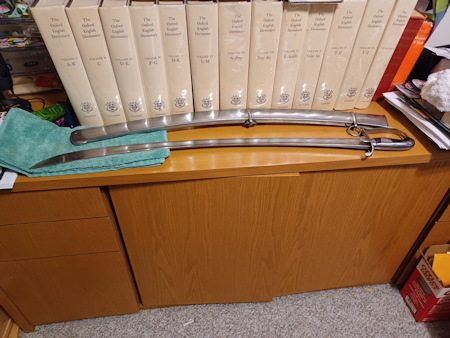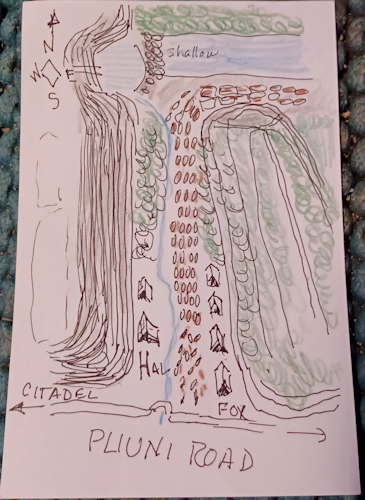Back on October 5, I emailed my agent Horngard I. Heard nothing. Finally called and asked (in the intervening days had a wonderful house-guest and we thoroughly enjoyed ourselves, talking, listening, reading, writing (me, then reading her bits of it), giving horses treats, enjoying the good weather, etc., etc. And cooking. She made chocolate pudding […] [...more]
Back on October 5, I emailed my agent Horngard I. Heard nothing. Finally called and asked (in the intervening days had a wonderful house-guest and we thoroughly enjoyed ourselves, talking, listening, reading, writing (me, then reading her bits of it), giving horses treats, enjoying the good weather, etc., etc. And cooking. She made chocolate pudding and brownies-from-scratch. I made chili from scratch. We had chili more than once (I just ate the last bowlful in the pot for supper and have two “short” quarts in the freezer. My mouth feels very tingly.)
So when I reached my agent (who was out of the office when I first called), turns out that email never arrived. Re-emailed, and it got there. So we’re back to square one in terms of waiting to see what he thinks of it.
House-guest will be working on a compilation of Paksworld stuff for me so I don’t have to search through all the books to maintain continuity and accuracy. Just the books (eleven, counting Horngard I) are now totalling 1.6 to 1.76 million words, with lengths between 155,000 and 176,000 words each. The Paksworld short fiction adds another 100,000+ words.
The eighteen non-Paksworld books — the 7 Serrano-Suiza books, the 7 Vatta books, the 2 McCaffrey collaborations, the 2 standalone books — are all over 100,000 each, mostly in the 120-130,000 range. So that’s another 2.25 million words, roughly and a grand total for the books alone of 3.8 to 4 million words. Plus the short fiction scattered through various markets (over 20 anthologies and ?? magazine publications.) I am a “wordy” woman. By no means the most words published of anyone in the field, but also not the least. Not the best, not the worst, either.
I sure hope Agent likes Horngard now, and we can get it to the market and into print sometime next year. And that Horngard II progresses without a hitch and gets me to 30. (No, that’s not an ultimate goal, just an interim. Love those zeros flipping the next number over.)
Horngard II is now coming along, though it’s run headfirst into a short piece I wrote this past summer. Headfirst as in–as they are now–they’re incompatible in who was where when. Something has to give way in one of them: when something happened, where something happened, who met whom at this other place. Neither Horngard II nor “Bank Transfer” has gone public yet, fortunately, but…which “darling” is going to have to be killed for the whole narrative to work? “Bank Transfer” was supposed to slot neatly between Horngard I and Horngard II, and the ambush scene AND the arrival of someone else (Ferran Count Andressat) on the north road into Horngard are now occupying that space & time. Usually the short Paksworld stuff is either remote in time or space from one of the books–so no problem with overlap. However, “Bank Transfer” was going to connect to later Horngard books through some of its characters, but it’s essential that the connection doesn’t conflict with what’s in the books. Right now, it’s…being tricky.
The best time for an ambush is when the people you’re planning to attack are off-guard for some reason, and in a place that makes it easier to pick them off than for your side to be picked off. If you have a small force and the other side has a large force (which you want to reduce a lot, rather than just kill one of) you want a way to confine them to an area (like a hog trap for wild hogs) where you can kill them without coming into full contact…trap them where a tide’s coming in fast, in a gorge with a flash flood coming, in quicksand, in any treacherous ground where they don’t know the hazard (e.g. that you’ve pre-dug pits with stakes in them and a light cover of dirt on something very breakable) , in any narrow declivity, etc. Minus modern technology, people traveling together in a group are unlikely to see through thick vegetation, around corners, over hills, in a fog, in heavy rain, while it’s snowing. For one thing, they’re paying most attention to the nearby people they’re moving with, so they don’t bump into them or get bumped into, or trip over minor obstacles on the road or trail. Even if you have the larger force and are ambushing a smaller force, and intend assassination rather than wholesale destruction, you’ll try to make it easier, less dangerous to your side, by picking the right place at the right time.
The details differ with place, season, local weather, experience level of the ambush designer (and more) but in these stories the lack of gunpowder and ordinary (to us) explosives, and the lack of modern communications, is always a factor. Here and now, light-speed communication can show a criminal’s face and the license plate of the car they’re border to border, sea to sea faster than the criminal can drive there–or fly. Not foolproof…hundreds of notices are issued each day and the farther the source, the less attention someone’s likely to pay to it, but the criminal cannot *count* on being unrecognized. The current GA trial involving (among other crimes) the invasion of the Cotton County, GA, elections office is a perfect example: surveillance tape caught the county employees who let unauthorized people into the building…actually doing so. And then caught them in the room with the voting machines. But in Paksworld–with no cameras, no phones, no electric lights, no internet, no way for a city official in one city to contact an official in another (“We chased a gang of robbers out of our city; we think they headed off east toward your city…they were all mounted and one of them had a spotted bay and white horse about 17 hands…”)–it’s much easier for a gang to get away, safely ahead of pursuit, and be unsuspected ordinary travelers in another city.


